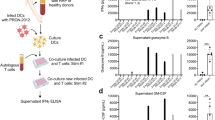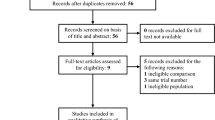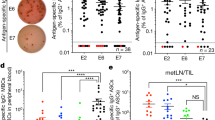Abstract
In the dose-escalation phase of a Phase I clinical trial in which six subjects each were vaccinated with PepCan at the 50, 100, 250, and 500 μg per peptide dose, the 50 μg dose showed the best histological regression rate. Ten additional subjects were vaccinated at this dose in the final dose phase. As with the dose-escalation phase, no dose-limiting toxicities were observed. Overall, the histological regression rates were 50 % at the 50 μg dose (7 of 14) and 100 μg dose (3 of 6), and 45 % overall (14 of 31). Of subjects in whom HPV type 16 (HPV 16) was detected at entry, it became undetectable in three subjects after vaccination, and the viral loads significantly decreased in nine subjects in whom HPV 16 infection was detected at entry and exit (p = 0.008). Immune profiling revealed increased T-helper type 1 cells after vaccinations (p = 0.02 and 0.0004 after 2 and 4 vaccinations, respectively). T-helper type 2 cells initially increased after two vaccinations (p = 0.01), but decreased below the baseline level after four vaccinations although not significantly. Pre-vaccination regulatory T cell levels were significantly lower in histological responders compared to non-responders (p = 0.03). Feasibility of testing plasma for multiplex cytokine/chemokine analysis and of performing proteomic analysis of PBMCs was examined for potentially identifying biomarkers in the future. While these analyses are feasible to perform, attention needs to be given to how soon the blood samples would be processed after phlebotomy. As sufficient safety of PepCan has been demonstrated, enrollment for the Phase II clinical trial has been opened.



Similar content being viewed by others
Abbreviations
- AE:
-
Adverse event
- β-NGF:
-
β-Nerve growth factor
- CCL7:
-
Chemokine (C–C motif) ligand 7
- CIN:
-
Cervical intraepithelial neoplasia
- CT:
-
Threshold cycle
- CXCL1:
-
Chemokine (C–X–C motif) ligand 1
- CXCL9:
-
Chemokine (C–X–C motif) ligand 9
- FASP:
-
Filter-aided sample preparation
- FGF:
-
Basic fibroblast growth factor
- HGF:
-
Hepatocyte growth factor
- HPV 16:
-
HPV type 16
- HSIL:
-
High-grade squamous intraepithelial lesion
- IL-1RA:
-
IL-1 receptor agonist
- IL-2Rα:
-
IL-2 receptor α
- IP-10:
-
IFN-γ-induced protein 10
- LC–MS/MS:
-
Liquid chromatography–dual mass spectrometry
- MCP-1:
-
Monocyte chemotactic protein 1
- MIF:
-
Macrophage migration inhibitory factor
- NaCl:
-
Sodium chloride
- PDGF-BB:
-
Platelet-derived growth factor subunit B
- RANTES:
-
Regulated on activation, normal T cell expressed and secreted
- SCF:
-
Stem cell factor
- SCGF-β:
-
Stem cell growth factor β
- VEGF:
-
Vascular endothelial growth factor
References
Cancer IAfRo (2012) Globocan 2012 cancer fact sheet
Chaturvedi AK (2010) Beyond cervical cancer: burden of other HPV-related cancers among men and women. J Adolesc Health 46(4 Suppl):S20–S26
Tota JE, Chevarie-Davis M, Richardson LA, Devries M, Franco EL (2011) Epidemiology and burden of HPV infection and related diseases: implications for prevention strategies. Prev Med 53(Suppl 1):S12–S21
Smith JS, Lindsay L, Hoots B, Keys J, Franceschi S, Winer R, Clifford GM (2007) Human papillomavirus type distribution in invasive cervical cancer and high-grade cervical lesions: a meta-analysis update. Int J Cancer 121(3):621–632
Nakagawa M, Greenfield W, Moerman-Herzog A, Coleman HN (2015) Cross-reactivity, epitope spreading, and de novo immune stimulation are possible mechanisms of cross-protection of nonvaccine human papillomavirus (HPV) types in recipients of HPV therapeutic vaccines. Clin Vaccine Immunol 22(7):679–687
Trimble CL, Morrow MP, Kraynyak KA, Shen X, Dallas M, Yan J, Edwards L, Parker RL, Denny L, Giffear M, Brown AS, Marcozzi-Pierce K, Shah D, Slager AM, Sylvester AJ, Khan A, Broderick KE, Juba RJ, Herring TA, Boyer J, Lee J, Sardesai NY, Weiner DB, Bagarazzi ML (2015) Safety, efficacy, and immunogenicity of VGX-3100, a therapeutic synthetic DNA vaccine targeting human papillomavirus 16 and 18 E6 and E7 proteins for cervical intraepithelial neoplasia 2/3: a randomised, double-blind, placebo-controlled phase 2b trial. Lancet 386(10008):2078–2088
Wang X, Coleman HN, Nagarajan U, Spencer HJ, Nakagawa M (2013) Candida skin test reagent as a novel adjuvant for a human papillomavirus peptide-based therapeutic vaccine. Vaccine 31(49):5806–5813
Clifton MM, Johnson SM, Roberson PK, Kincannon J, Horn TD (2003) Immunotherapy for recalcitrant warts in children using intralesional mumps or Candida antigens. Pediatr Dermatol 20(3):268–271
Horn TD, Johnson SM, Helm RM, Roberson PK (2005) Intralesional immunotherapy of warts with mumps, Candida, and Trichophyton skin test antigens: a single-blinded, randomized, and controlled trial. Arch Dermatol 141(5):589–594
Johnson SM, Horn TD (2004) Intralesional immunotherapy for warts using a combination of skin test antigens: a safe and effective therapy. J Drugs Dermatol 3(3):263–265
Johnson SM, Roberson PK, Horn TD (2001) Intralesional injection of mumps or Candida skin test antigens: a novel immunotherapy for warts. Arch Dermatol 137(4):451–455
Phillips RC, Ruhl TS, Pfenninger JL, Garber MR (2000) Treatment of warts with Candida antigen injection. Arch Dermatol 136(10):1274–1275
Maronn M, Salm C, Lyon V, Galbraith S (2008) One-year experience with candida antigen immunotherapy for warts and molluscum. Pediatr Dermatol 25(2):189–192
Nakagawa M, Coleman HN, Wang X, Daniels J, Sikes J, Nagarajan UM (2014) IL-12 secretion by Langerhans cells stimulated with Candida skin test reagent is mediated by dectin-1 in some healthy individuals. Cytokine 65(2):202–209
Bruinsma FJ, Quinn MA (2011) The risk of preterm birth following treatment for precancerous changes in the cervix: a systematic review and meta-analysis. BJOG 118(9):1031–1041
Hildesheim A, Herrero R, Wacholder S, Rodriguez AC, Solomon D, Bratti MC, Schiller JT, Gonzalez P, Dubin G, Porras C, Jimenez SE, Lowy DR (2007) Effect of human papillomavirus 16/18 L1 viruslike particle vaccine among young women with preexisting infection: a randomized trial. JAMA 298(7):743–753
Greenfield WW, Stratton SL, Myrick RS, Vaughn R, Donnalley LM, Coleman HN, Mercado M, Moerman-Herzog AM, Spencer HJ, Andrews-Collins NR, Hitt WC, Low GM, Manning NA, McKelvey SS, Smith D, Smith MV, Phillips AM, Quick CM, Jeffus SK, Hutchins LF, Nakagawa M (2015) A phase I dose-escalation clinical trial of a peptide-based human papillomavirus therapeutic vaccine with Candida skin test reagent as a novel vaccine adjuvant for treating women with biopsy-proven cervical intraepithelial neoplasia 2/3. Oncoimmunology 4(10):e1031439
Mirabello L, Schiffman M, Ghosh A, Rodriguez AC, Vasiljevic N, Wentzensen N, Herrero R, Hildesheim A, Wacholder S, Scibior-Bentkowska D, Burk RD, Lorincz AT (2013) Elevated methylation of HPV16 DNA is associated with the development of high grade cervical intraepithelial neoplasia. Int J Cancer 132(6):1412–1422
Cricca M, Morselli-Labate AM, Venturoli S, Ambretti S, Gentilomi GA, Gallinella G, Costa S, Musiani M, Zerbini M (2007) Viral DNA load, physical status and E2/E6 ratio as markers to grade HPV16 positive women for high-grade cervical lesions. Gynecol Oncol 106(3):549–557
Gravitt PE, Peyton C, Wheeler C, Apple R, Higuchi R, Shah KV (2003) Reproducibility of HPV 16 and HPV 18 viral load quantitation using TaqMan real-time PCR assays. J Virol Methods 112(1–2):23–33
Wisniewski JR, Zougman A, Nagaraj N, Mann M (2009) Universal sample preparation method for proteome analysis. Nat Methods 6(5):359–362
Luber CA, Cox J, Lauterbach H, Fancke B, Selbach M, Tschopp J, Akira S, Wiegand M, Hochrein H, O’Keeffe M, Mann M (2010) Quantitative proteomics reveals subset-specific viral recognition in dendritic cells. Immunity 32(2):279–289
Nesvizhskii AI, Keller A, Kolker E, Aebersold R (2003) A statistical model for identifying proteins by tandem mass spectrometry. Anal Chem 75(17):4646–4658
Smyth GK (2004) Linear models and empirical bayes methods for assessing differential expression in microarray experiments. Stat Appl Genet Mol Biol 3(1):1–25
Kenter GG, Welters MJ, Valentijn AR, Lowik MJ, Berends-van der Meer DM, Vloon AP, Essahsah F, Fathers LM, Offringa R, Drijfhout JW, Wafelman AR, Oostendorp J, Fleuren GJ, van der Burg SH, Melief CJ (2009) Vaccination against HPV-16 oncoproteins for vulvar intraepithelial neoplasia. N Engl J Med 361(19):1838–1847
Carcopino X, Bolger N, Henry M, Mancini J, Boubli L, Olive D, Cleary S, Prendiville W, Tamalet C (2011) Evaluation of type-specific HPV persistence and high-risk HPV viral load quantitation in HPV positive women under 30 with normal cervical cytology. J Med Virol 83(4):637–643
Daayana S, Elkord E, Winters U, Pawlita M, Roden R, Stern PL, Kitchener HC (2010) Phase II trial of imiquimod and HPV therapeutic vaccination in patients with vulval intraepithelial neoplasia. Br J Cancer 102(7):1129–1136
Ignatov A, Robert J, Gregory-Evans C, Schaller HC (2006) RANTES stimulates Ca2+ mobilization and inositol trisphosphate (IP3) formation in cells transfected with G protein-coupled receptor 75. Br J Pharmacol 149(5):490–497
Schall TJ, Bacon K, Toy KJ, Goeddel DV (1990) Selective attraction of monocytes and T lymphocytes of the memory phenotype by cytokine RANTES. Nature 347(6294):669–671
Kohlmeier JE, Miller SC, Smith J, Lu B, Gerard C, Cookenham T, Roberts AD, Woodland DL (2008) The chemokine receptor CCR5 plays a key role in the early memory CD8+ T cell response to respiratory virus infections. Immunity 29(1):101–113
Kameyoshi Y, Dorschner A, Mallet AI, Christophers E, Schroder JM (1992) Cytokine RANTES released by thrombin-stimulated platelets is a potent attractant for human eosinophils. J Exp Med 176(2):587–592
Lin CL, Suri RM, Rahdon RA, Austyn JM, Roake JA (1998) Dendritic cell chemotaxis and transendothelial migration are induced by distinct chemokines and are regulated on maturation. Eur J Immunol 28(12):4114–4122
Romagnani S (2002) Cytokines and chemoattractants in allergic inflammation. Mol Immunol 38(12–13):881–885
Maghazachi AA, Al-Aoukaty A, Schall TJ (1996) CC chemokines induce the generation of killer cells from CD56+ cells. Eur J Immunol 26(2):315–319
Niwa Y, Akamatsu H, Niwa H, Sumi H, Ozaki Y, Abe A (2001) Correlation of tissue and plasma RANTES levels with disease course in patients with breast or cervical cancer. Clin Cancer Res 7(2):285–289
Acknowledgments
This study was supported by a number of grants from National Institutes of Health. “Understanding and Enhancing T-Cell Responses to High Risk Human Papillomaviruses” (R01CA143130) and the Translational Research Institute (UL1TR000039) supported the Phase I clinical trial. The University of Arkansas for Medical Sciences Proteomics Core Laboratory is supported by the Arkansas IDeA Network for Biomedical Research Excellence (P20GM103429), the University of Arkansas Center for Protein Structure and Function (P30GM103450), and the University of Arkansas for Medical Sciences Center for Microbial Pathogenesis and Host Inflammatory Responses (P20GM103625).
Author information
Authors and Affiliations
Corresponding author
Ethics declarations
Conflict of interest
Mayumi Nakagawa is one of the inventors named in patents and patent applications describing PepCan. Other authors do not have any conflict of interest to disclose.
Ethical approval
All procedures performed in studies involving human participants were in accordance with the ethical standards of the Institutional Review Board, the Food and Drug Administration, and with the 1964 Helsinki Declaration including its later amendments.
Informed consent
Informed consent was obtained from all individual participants included in the study.
Electronic supplementary material
Below is the link to the electronic supplementary material.
Rights and permissions
About this article
Cite this article
Coleman, H.N., Greenfield, W.W., Stratton, S.L. et al. Human papillomavirus type 16 viral load is decreased following a therapeutic vaccination. Cancer Immunol Immunother 65, 563–573 (2016). https://doi.org/10.1007/s00262-016-1821-x
Received:
Accepted:
Published:
Issue Date:
DOI: https://doi.org/10.1007/s00262-016-1821-x




